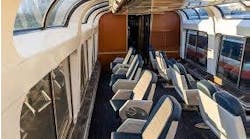Subcommittee on Railroads, Pipelines, and Hazardous Materials Chairman Jeff Denham (R-CA) delivered the following opening remarks at the July 9 Transportation and Infrastructure hearing on “The Role of Innovative Finance in Intercity Passenger Rail.”
The hearing examined ways to utilize innovative financing to deliver effective intercity passenger rail service. With the upcoming expiration of the Passenger Rail Investment and Improvement Act of 2008 (PRIIA), reauthorization is one of the Transportation and Infrastructure Committee’s top priorities. The 2008 law focused on improving rail performance and the financial viability of Amtrak; the reauthorization will build upon the success of the 2008 law to deliver the most effective passenger rail systems possible.
Chairman Denham and subcommittee members heard testimony from several witnesses at the hearing including The Honorable John Porcari, deputy secretary, U.S. Department of Transportation; Beverley K. Swaim-Staley, president and CEO, Union Station Redevelopment Corp.; Frank Chechile, CEO, Parallel Infrastructure; and John Robert Smith, former mayor of Meridian, Miss., president and CEO, Reconnecting America.
Chairman Jeff Denham (R-CA)
Subcommittee on Railroads, Pipelines and Hazardous Materials
Hearing on Innovative Finance in Intercity Passenger Rail
July 9, 2013
Opening Statement
(Remarks as Prepared)
As I have said at every hearing we’ve held, I am committed to rail reauthorization this year. One area the next rail bill will likely need to address is the role innovative financing tools can play to advance intercity passenger rail projects.
We all need to be creative in ways to stretch federal dollars and work with our partners in the states, with communities, and with the private sector.
I have consistently advocated for the need to leverage private sector financing in my home state for the construction of high speed rail. Without private sector engagement and financing, the California project is doomed to repeat the mistakes of the past and will require endless subsidies from federal taxpayers.
Innovative finance has been increasingly used in the United States for highway and mass transit projects, and one of my goals for the upcoming reauthorization is extend that trend to passenger rail.
The Railroad Rehabilitation and Improvement Financing loan program is an example of a program I’d like to leverage more. Currently RRIF is authorized to lend up to $35 billion in loans and loan guarantees for the development of railroad infrastructure. The program was created principally for short line and class I freight railroads, though recently commuter and intercity passenger rail operators have expressed interest in the program.
RRIF and other Federal credit programs can accelerate large infrastructure projects, if stakeholders come together to identify repayment sources. For example, Denver is utilizing RRIF and TIFIA to complete a major expansion of Denver Union Station, which will improve intercity rail, commuter rail, and bus connections. The loans are being repaid with a combination of local revenue sources.
This is an excellent example of states, the private sector and the federal government partnering to build more infrastructure in new and creative ways. We need to encourage more of this type of innovative thinking at the state and local levels so entities like Altamont Commuter Express in my home state can make the infrastructure upgrades they need for the future.
Station development is another tool that can be leveraged to support expanded and improved passenger rail services. Rail stations are often located in desirable, downtown locations, and can become the focus around which significant residential, commercial, and retail development can occur.
Value capture methods such as tax increment financing can be a means to leverage that private sector development to spur transportation improvements.
Finally, railroads themselves can proactively use their own property to create additional funding sources. For instance, railroad rights-of-way can be used to place telecommunication and other non-transportation infrastructure. In 2012 Amtrak generated $94 million in real estate-related revenue, and I would like to work with them to grow that number.
Again, I thank the witnesses for being here today.




